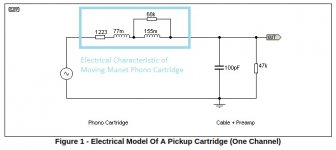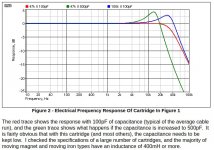In the 1970s I was designing and building tube amps with global feedback and (GASP) transistorized power supplies and constant current sources.
Heresy, I know. But there you go.
Heresy, I know. But there you go.
It was the early 80s for me, and more so when I got back into it in the early part of the century. My business partner has seen the pics of the last one and wants me to build a copy but pretty this time, an architectural / stylish statement that makes guests pause and ask 'what is that'? It was very dissimilar to traditional designs and had a great transfer function and low Zout.In the 1970s I was designing and building tube amps with global feedback and (GASP) transistorized power supplies and constant current sources.
Heresy, I know. But there you go.
I have to lean with Brett's comments and beliefs, simply because this bi-amping/bi-wiring thing is just a marketing tool, a fad, just like any other fad.
"The more wires, terminals, etc.the better" seems to entice the masses towards giving in to such ideas.
Like the infamous "Wattage Wars" of the late 1970's.
Up goes the price naturally, and you're now paying for wattage you'll likely never use.
But....
You can now brag about it.
"The more wires, terminals, etc.the better" seems to entice the masses towards giving in to such ideas.
Like the infamous "Wattage Wars" of the late 1970's.
Up goes the price naturally, and you're now paying for wattage you'll likely never use.
But....
You can now brag about it.
Thanks WOT, but I'm always happy to be proven wrong with good data. Just yet to see it, like many other claims such as power regenerators.I have to lean with Brett's comments and beliefs, simply because this bi-amping/bi-wiring thing is just a marketing tool, a fad, just like any other fad.
I was just messing around with some bad earthing arrangements and some 1 ohm resistors dotted around a schematic in a simulator, and apart from that blatently incompetent example I gave, which was bypassing part of the tweeter filter, I found nothing interesting beyond the expected loss of level from lossy interconnects.
I know how this stuff works, and the losses in a speaker depend slightly on the impedance curve. The flatter the better really. I think everyone knows that using bell wire for speakers does make the bass flabby on reflex because a voltage amp loses damping factor. But that isn't distortion, just tonal.
I'll file it away along with boutique capacitors and Mills resistors as the great unknown. And forget about it. 🙂
I know how this stuff works, and the losses in a speaker depend slightly on the impedance curve. The flatter the better really. I think everyone knows that using bell wire for speakers does make the bass flabby on reflex because a voltage amp loses damping factor. But that isn't distortion, just tonal.
I'll file it away along with boutique capacitors and Mills resistors as the great unknown. And forget about it. 🙂
It is much more than just tonal. If you input a transient signal, say an impulse, step, piano key hitting a low string, tympani, etc. you will see (hear) significant ringing, which is quite unlike a tone control, for example. Time domain aberrations aren't necessarily visible when viewing circuit simulations in the frequency domain.I think everyone knows that using bell wire for speakers does make the bass flabby on reflex because a voltage amp loses damping factor. But that isn't distortion, just tonal.
Last edited:
I have to lean with Brett's comments and beliefs, simply because this bi-amping/bi-wiring thing is just a marketing tool, a fad, just like any other fad.
Thanks WOT, but I'm always happy to be proven wrong with good data. Just yet to see it, like many other claims such as power regenerators.
Ok, here's my take on things......
For decades, speaker systems were designed and produced for the consumer using expensive laboratory equipment and anechoic chambers, and field testing by human ears.
Those designers wanted to please the customer's ears so that they'd buy their product(s).
The company's reputation was at stake of course.
And they managed to produce some highly popular and esteemed systems of all types.
And what did they all have in common?
TWO terminals on the back, marked plus and minus.
The work was done, over, finished...... period.
Now along comes that nasty Marketing Tool.... sometimes called innovation, among other things.
It wasn't good enough, those two measily terminals, they decided to add more, with promises of things like enhanced flexibility, personalization, and a host of other marketing jive talk.
Some snotnose young college punk dreamt it up and got a raise/dividend from his boss....
Sure, strapping those now four terminals into two produced a well-designed system for conventional use.
But to justify the higher prices in step with inflation, and satisfy the manufacturer's additional income, they came up with this new "fad" along with the manufacturers of amplifiers, to bi-amp things, and intrique the consumer's minds enough to make this new form of design worthy of the (additional) cost.
Basing things on "perception" is always a powerful tool.
And like other forms of "snake oil sales" it naturally took off.
I've even seen small, tabletop stereo radios with small speakers using the bi-amp wiring.
Like the sound from a 4 inch woofer and cheap piezo tweeter is really going to improve with that?........ gimme a break.
It's marketing....a gimmick.....
Of course the choice is yours, if you want to buy into it.
Last edited:
Since I have the diagrams already prepared for another rambling thread, here's the lowdown on very bad cabling.
If you have an inductive moving magnet record pickup attached to a 120 ohm phono cable, very bad things happen. The mismatch produces a capacitance that resonates with the inductive pickup. That might just be tonal, and not what I would call non-linear distortion. But the pickup, being a mechanical device then tries to jump out of the LP groove, which is nasty and non-linear.
It's never been solved really. But an 8 ohm loudspeaker attached to a 100 ohm super cable can only let the signal bounce around about 10 times. Well do the Math. Electricity travels at the speed of light, which is a Million times faster than Sound. If there's any effect it's nothing I can't fix with tone-controls.
As a keen audio man, I have more pressing problems to solve. Now must get on. 🙂
If you have an inductive moving magnet record pickup attached to a 120 ohm phono cable, very bad things happen. The mismatch produces a capacitance that resonates with the inductive pickup. That might just be tonal, and not what I would call non-linear distortion. But the pickup, being a mechanical device then tries to jump out of the LP groove, which is nasty and non-linear.
It's never been solved really. But an 8 ohm loudspeaker attached to a 100 ohm super cable can only let the signal bounce around about 10 times. Well do the Math. Electricity travels at the speed of light, which is a Million times faster than Sound. If there's any effect it's nothing I can't fix with tone-controls.
As a keen audio man, I have more pressing problems to solve. Now must get on. 🙂
Attachments
Back to my original question, the reason I asked is that I had heard an opinion that bi-wiring makes very little sonic difference, and it may actually be better to let both runs of the bi-wire feed the power hungry bass section by leaving the jumpers in.If you bi-wire your speakers, is it better to remove the jumper cables, or to keep them?
Back to my original question, the reason I asked is that I had heard an opinion that bi-wiring makes very little sonic difference, and it may actually be better to let both runs of the bi-wire feed the power hungry bass section by leaving the jumpers in.
There's no need to run more than one pair of wires if the jumper is in place.
Simple lamp cord 18 or 16 gauge is sufficient up to 30 feet from the amp.
- Home
- Loudspeakers
- Multi-Way
- Bi-wire plus jumpers

